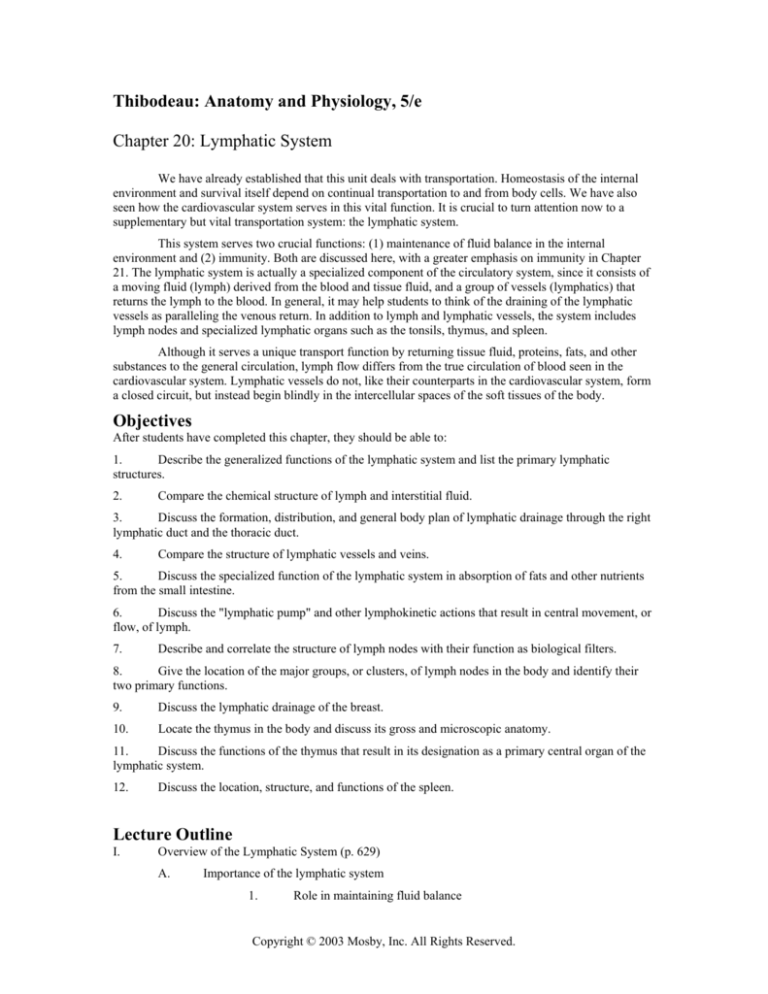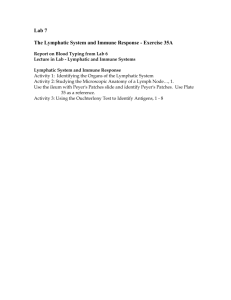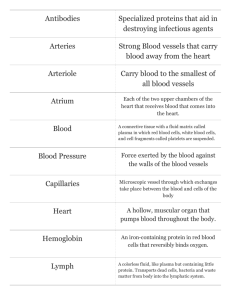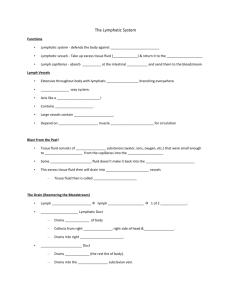
Thibodeau: Anatomy and Physiology, 5/e
Chapter 20: Lymphatic System
We have already established that this unit deals with transportation. Homeostasis of the internal
environment and survival itself depend on continual transportation to and from body cells. We have also
seen how the cardiovascular system serves in this vital function. It is crucial to turn attention now to a
supplementary but vital transportation system: the lymphatic system.
This system serves two crucial functions: (1) maintenance of fluid balance in the internal
environment and (2) immunity. Both are discussed here, with a greater emphasis on immunity in Chapter
21. The lymphatic system is actually a specialized component of the circulatory system, since it consists of
a moving fluid (lymph) derived from the blood and tissue fluid, and a group of vessels (lymphatics) that
returns the lymph to the blood. In general, it may help students to think of the draining of the lymphatic
vessels as paralleling the venous return. In addition to lymph and lymphatic vessels, the system includes
lymph nodes and specialized lymphatic organs such as the tonsils, thymus, and spleen.
Although it serves a unique transport function by returning tissue fluid, proteins, fats, and other
substances to the general circulation, lymph flow differs from the true circulation of blood seen in the
cardiovascular system. Lymphatic vessels do not, like their counterparts in the cardiovascular system, form
a closed circuit, but instead begin blindly in the intercellular spaces of the soft tissues of the body.
Objectives
After students have completed this chapter, they should be able to:
1.
Describe the generalized functions of the lymphatic system and list the primary lymphatic
structures.
2.
Compare the chemical structure of lymph and interstitial fluid.
3.
Discuss the formation, distribution, and general body plan of lymphatic drainage through the right
lymphatic duct and the thoracic duct.
4.
Compare the structure of lymphatic vessels and veins.
5.
Discuss the specialized function of the lymphatic system in absorption of fats and other nutrients
from the small intestine.
6.
Discuss the "lymphatic pump" and other lymphokinetic actions that result in central movement, or
flow, of lymph.
7.
Describe and correlate the structure of lymph nodes with their function as biological filters.
8.
Give the location of the major groups, or clusters, of lymph nodes in the body and identify their
two primary functions.
9.
Discuss the lymphatic drainage of the breast.
10.
Locate the thymus in the body and discuss its gross and microscopic anatomy.
11.
Discuss the functions of the thymus that result in its designation as a primary central organ of the
lymphatic system.
12.
Discuss the location, structure, and functions of the spleen.
Lecture Outline
I.
Overview of the Lymphatic System (p. 629)
A.
Importance of the lymphatic system
1.
Role in maintaining fluid balance
Copyright © 2003 Mosby, Inc. All Rights Reserved.
Chapter 20: Lymphatic System
a.
2
Returns interstitial fluid to blood
1)
b.
c.
II.
Returns proteins to blood that accidentally leak from
capillaries
1)
Essential to maintain colloidal osmotic pressure in
blood
2)
If not returned, edema and death will result
Returns fats and other substances to blood
2.
Role in immunity (Chapter 21)
3.
Structure of lymphatic system (Fig. 20-1)
a.
Lymph
b.
Lymph vessels
c.
Lymph nodes
d.
Isolated nodules of lymphatic tissue
e.
Lymphatic organs (Fig. 20-2)
Lymph and Interstitial Fluid (p. 630)
A.
Interstitial fluid—fills spaces between cells
1.
B.
Source
a.
Formed from blood plasma water leaking from capillaries
b.
Also formed by small amounts of protein and other molecules
that leak from capillaries
Lymph—found in lymphatic vessels
1.
Source
a.
2.
C.
III.
Excess fluid not returned to capillaries
Formed by interstitial fluid mixing with protein after entering
the lymphatic capillaries
Composition
a.
Water
b.
Protein
c.
Fat and other substances
Both fluids resemble blood plasma in composition
Lymphatic Vessels (p. 631)
A.
Distribution of lymphatic vessels (Fig. 20-2)
1.
Lymphatic capillaries (Fig. 20-1)
a.
Lacteals (Fig. 25-14)
b.
Blind-ended capillaries (Fig. 20-3)
c.
Endothelial cells attached to tissue by connective tissue
filaments
d.
Pores between endothelial cells—open as volume of
interstitial fluid increases
Copyright © 2003 Mosby, Inc. All Rights Reserved.
Chapter 20: Lymphatic System
e.
2.
2.
IV.
Resemble veins except:
a.
Lymphatics have thinner walls
b.
Lymphatics contain more valves
c.
Lymphatics contain lymph nodes
Numerous semilunar valves present (Fig. 20-3)
Functions of lymphatic vessels
1.
Return fluid to blood
2.
Return proteins and large particulate to blood
3.
Fat and other nutrients from small intestine absorbed by lacteals
Circulation of Lymph (p. 631)
A.
V.
Drains lymph from right lower quadrant of body and entire
left side of the body into the subclavian vein
Structure of lymphatic vessels
1.
C.
Drains lymph from right upper quadrant of body into right
subclavian vein
Thoracic duct—originates from the cisterna chyli in the lumbar region
(Fig. 20-2)
a.
B.
Formed by merger of lymphatic capillaries and small
lymphatics
Right lymphatic duct (Fig. 20-2)
a.
4.
Networks of lymphatic capillaries in tissues
Larger lymphatic vessels
a.
3.
3
The lymphatic pump
1.
One-way valves in lymphatics
2.
Movement caused by:
a.
Breathing movements
b.
Skeletal muscle contractions
c.
Arterial pulsations
d.
Postural changes
e.
Massage of soft tissues
Lymph Nodes (p. 632)
A.
Structure of lymph nodes (Fig. 20-4)
1.
Each lymph node is surrounded by a fibrous capsule, which extends
inward, dividing node into several cortical nodules
2.
Each cortical nodule is filled with B lymphocytes
3.
Around each cortical nodule are sinuses with the lymph
4.
In the center of the node is the medulla, composed of medullary cords
and sinuses
5.
Medullary sinuses are filled with phagocytic reticuloendothelial cells
Copyright © 2003 Mosby, Inc. All Rights Reserved.
Chapter 20: Lymphatic System
B.
C.
6.
Lymph enters the cortical sinuses from several afferent lymph vessels
7.
Lymph flows into medullary sinuses and then out one efferent lymph
vessel
Locations of lymph nodes (Fig. 20-2)
1.
Preauricular lymph nodes
2.
Submental and submaxillary lymph nodes
3.
Superficial cervical lymph nodes
4.
Superficial cubital, or supratrochlear, lymph nodes
5.
Axillary lymph nodes
6.
Inguinal lymph nodes
Functions of lymph nodes
1.
2.
Defense (Fig. 20-5)
a.
Filtration
b.
Phagocytosis
Hematopoiesis
a.
VI.
B.
Two sets of lymphatics draining the breast
1.
Lymphatics that originate in and drain skin over the breast
2.
Lymphatics that originate in and drain breast substance
Lymph nodes associated with the breast
1.
VIII.
85% of lymph from breast enters lymph nodes of axillary region.
Tonsils (Fig. 20-7)
A.
Palatine tonsils (tonsils)
B.
Pharyngeal tonsils (adenoids)
C.
Lingual tonsils
Thymus (Fig. 20-8)
A.
Structure of the thymus
1.
B.
IX.
Maturation of some lymphocytes and monocytes that migrated
from red marrow
Lymphatic Drainage of the Breast (Fig. 20-6)
A.
VII.
4
Each lobe divided into lobules, each with a cortex and medulla
Function of the thymus
1.
Immature lymphocytes formed in red marrow move to thymus
2.
Lymphocytes mature and are distributed to the spleen, lymph nodes,
and lymphoid tissue before birth
3.
After birth, thymus secretes thymosin, which enables lymphocytes to
develop into T cells
Spleen (p. 637)
A.
Location of the spleen (Fig. 20-2)
Copyright © 2003 Mosby, Inc. All Rights Reserved.
Chapter 20: Lymphatic System
B.
Structure of the spleen (Fig. 20-9)
1.
C.
Blood enters the white pulp (full of lymphocytes), then the red pulp,
then venous sinuses and into veins
Functions of the spleen
1.
Defense
a.
2.
3.
4.
XI.
XII.
Bacteria is eaten by reticuloendothelial cells lining venous
sinuses
Hematopoiesis
a.
Maturing of monocytes and lymphocytes
b.
RBCs formed before birth
Red blood cell and platelet destruction
a.
X.
5
Worn RBCs phagocytosed by sinusoid reticuloendothelial
cells
Blood reservoir
a.
Normal volume of 350 ml.
b.
Volume decreased by about 200 ml by sympathetic
stimulation
Cycle of Life: Lymphatic System (p. 638)
A.
Most organs containing developing lymphocytes quit growing at puberty
B.
Organs (thymus, lymph nodes, tonsils, etc.) begin to atrophy
C.
Spleen remains intact and does not atrophy
D.
Late adulthood—deficiency of immune system
1.
Greater risk of cancer and infections
2.
Autoimmune conditions more likely
The Big Picture: Lymphatic System and the Whole Body (p. 639)
A.
Fluid runoff collected by lymphatic system
B.
Lymph nodes—treatment facilities that remove contaminants
C.
Clean fluid returned to bloodstream
D.
Disease prevention
Mechanisms of Disease: Disorders of the Lymphatic System (p. 639)
A.
B.
Disorders associated with lymphatic vessels
1.
Lymphedema (Fig. 20-10)
2.
Lymphangitis
Disorders associated with lymph nodes and other lymphatic organs
1.
2.
Lymphoma
a.
Hodgkin lymphoma
b.
Non-Hodgkin lymphoma
Tonsillitis
Copyright © 2003 Mosby, Inc. All Rights Reserved.
Chapter 20: Lymphatic System
3.
Adenoids
Copyright © 2003 Mosby, Inc. All Rights Reserved.
6









